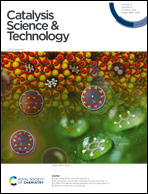Insight into the mechanism of boron-doping of carbon aerogel for enhancing the activity of low-temperature selective catalytic reduction of NO with NH3†
Abstract
Boron-doping of carbon aerogel (B-CA) was enabled by incorporating phenylboronic acid in the sol–gel process into the organic gel from resorcinol–formaldehyde and the role of boron-doping on the catalytic activity in selective reduction of NO with NH3 (NH3-SCR) in comparison with the undoped one (CA) was investigated. Results indicate that both B-CA and CA exhibit a mesopore–micropore structure while B-CA has a boron content of 3.62 at% in the forms of BC3 (each boron bonded with three carbon atoms), BC2O (each boron bonded with two carbon atoms and one oxygen atom) and BCO2 (each boron bonded with one carbon atom and two oxygen atoms). Boron doping significantly reduces the apparent activation energy of the NH3-SCR from 53.9 to 23.76 kJ mol−1 at the temperature regime (80–120 °C) while the apparent activation energy is a negative value of −19.15 kJ mol−1 between 140 and 200 °C. DFT calculation of a model graphene structure incorporated with BC3, BC2O and BCO2 sites reveals that NH3 adsorption is exothermic most on BCO2 and has a negative temperature dependence, which is mainly associated with the Lewis acid sites having electron deficiency boron atoms while O2 adsorption is endothermic least on BC3 and has a positive temperature dependence. The Lewis acid sites in B-CA play an important role in adsorption and dissociation of NH3 and O2, which is favorable for NO reduction to N2via NH3-SCR. The intermediates and species identified by the time-varying in situ DRIFTS indicate that B-CA has both a higher catalytic activity for NH3 dissociation to give more abundant hydrogen-bonded ammonia species and a higher catalytic activity for NO oxidation by O2 to form NO2 than CA, which jointly contribute to the higher NO conversion rate to nitrogen via NH3-SCR on B-CA. Moreover, carbon oxidation on CA surface by NO + O2 is much easier than that on B-CA while the latter is negligible.



 Please wait while we load your content...
Please wait while we load your content...